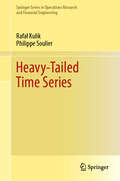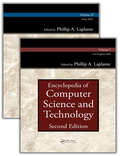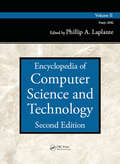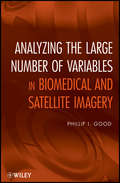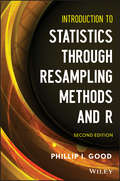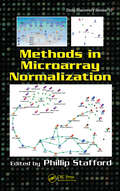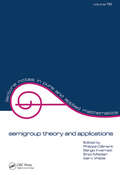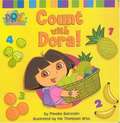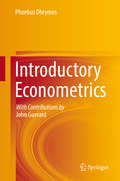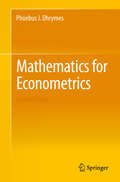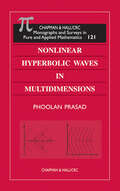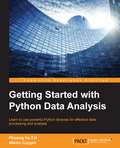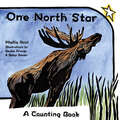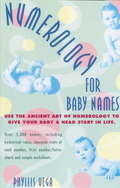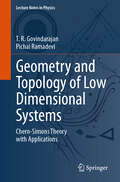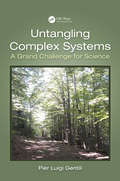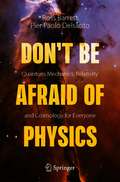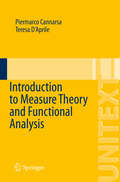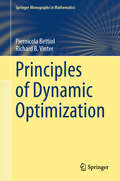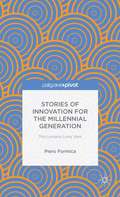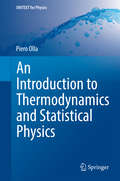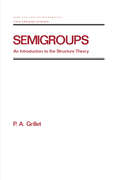- Table View
- List View
Heavy-Tailed Time Series (Springer Series in Operations Research and Financial Engineering)
by Rafal Kulik Philippe SoulierThis book aims to present a comprehensive, self-contained, and concise overview of extreme value theory for time series, incorporating the latest research trends alongside classical methodology. Appropriate for graduate coursework or professional reference, the book requires a background in extreme value theory for i.i.d. data and basics of time series. Following a brief review of foundational concepts, it progresses linearly through topics in limit theorems and time series models while including historical insights at each chapter’s conclusion. Additionally, the book incorporates complete proofs and exercises with solutions as well as substantive reference lists and appendices, featuring a novel commentary on the theory of vague convergence.
Encyclopedia of Computer Science and Technology
by Phillip A. LaplanteWith breadth and depth of coverage, the Encyclopedia of Computer Science and Technology, Second Edition has a multi-disciplinary scope, drawing together comprehensive coverage of the inter-related aspects of computer science and technology. The topics covered in this encyclopedia include: General and reference Hardware Computer systems organization Networks Software and its engineering Theory of computation Mathematics of computing Information systems Security and privacy Human-centered computing Computing methodologies Applied computing Professional issues Leading figures in the history of computer science The encyclopedia is structured according to the ACM Computing Classification System (CCS), first published in 1988 but subsequently revised in 2012. This classification system is the most comprehensive and is considered the de facto ontological framework for the computing field. The encyclopedia brings together the information and historical context that students, practicing professionals, researchers, and academicians need to have a strong and solid foundation in all aspects of computer science and technology.
Encyclopedia of Computer Science and Technology Volume II
by Phillip A. LaplanteThis book covers all aspects of computer science, engineering, and technology. It includes computer scientists, computer engineers computing professionals, managers, software professionals, and other technology professionals.
Encyclopedia of Software Engineering Three-Volume Set (Print)
by Phillip A. LaplanteSoftware engineering requires specialized knowledge of a broad spectrum of topics, including the construction of software and the platforms, applications, and environments in which the software operates as well as an understanding of the people who build and use the software. Offering an authoritative perspective, the two volumes of the Encyclopedia of Software Engineering cover the entire multidisciplinary scope of this important field. More than 200 expert contributors and reviewers from industry and academia across 21 countries provide easy-to-read entries that cover software requirements, design, construction, testing, maintenance, configuration management, quality control, and software engineering management tools and methods. Editor Phillip A. Laplante uses the most universally recognized definition of the areas of relevance to software engineering, the Software Engineering Body of Knowledge (SWEBOK®), as a template for organizing the material. Also available in an electronic format, this encyclopedia supplies software engineering students, IT professionals, researchers, managers, and scholars with unrivaled coverage of the topics that encompass this ever-changing field. Also Available OnlineThis Taylor & Francis encyclopedia is also available through online subscription, offering a variety of extra benefits for researchers, students, and librarians, including: Citation tracking and alerts Active reference linking Saved searches and marked lists HTML and PDF format options Contact Taylor and Francis for more information or to inquire about subscription options and print/online combination packages.US: (Tel) 1.888.318.2367; (E-mail) e-reference@taylorandfrancis.comInternational: (Tel) +44 (0) 20 7017 6062; (E-mail) online.sales@tandf.co.uk
Analyzing the Large Number of Variables in Biomedical and Satellite Imagery
by Phillip I. GoodThis book grew out of an online interactive offered through statcourse.com, and it soon became apparent to the author that the course was too limited in terms of time and length in light of the broad backgrounds of the enrolled students. The statisticians who took the course needed to be brought up to speed both on the biological context as well as on the specialized statistical methods needed to handle large arrays. Biologists and physicians, even though fully knowledgeable concerning the procedures used to generate microaarrays, EEGs, or MRIs, needed a full introduction to the resampling methods--the bootstrap, decision trees, and permutation tests, before the specialized methods applicable to large arrays could be introduced. As the intended audience for this book consists both of statisticians and of medical and biological research workers as well as all those research workers who make use of satellite imagery including agronomists and meteorologists, the book provides a step-by-step approach to not only the specialized methods needed to analyze the data from microarrays and images, but also to the resampling methods, step-down multi-comparison procedures, multivariate analysis, as well as data collection and pre-processing. While many alternate techniques for analysis have been introduced in the past decade, the author has selected only those techniques for which software is available along with a list of the available links from which the software may be purchased or downloaded without charge. Topical coverage includes: very large arrays; permutation tests; applying permutation tests; gathering and preparing data for analysis; multiple tests; bootstrap; applying the bootstrap; classification methods; decision trees; and applying decision trees.
Introduction to Statistics Through Resampling Methods and R
by Phillip I. GoodA highly accessible alternative approach to basic statistics Praise for the First Edition: "Certainly one of the most impressive little paperback 200-page introductory statistics books that I will ever see . . . it would make a good nightstand book for every statistician."--Technometrics Written in a highly accessible style, Introduction to Statistics through Resampling Methods and R, Second Edition guides students in the understanding of descriptive statistics, estimation, hypothesis testing, and model building. The book emphasizes the discovery method, enabling readers to ascertain solutions on their own rather than simply copy answers or apply a formula by rote. The Second Edition utilizes the R programming language to simplify tedious computations, illustrate new concepts, and assist readers in completing exercises. The text facilitates quick learning through the use of: More than 250 exercises--with selected "hints"--scattered throughout to stimulate readers' thinking and to actively engage them in applying their newfound skills An increased focus on why a method is introduced Multiple explanations of basic concepts Real-life applications in a variety of disciplines Dozens of thought-provoking, problem-solving questions in the final chapter to assist readers in applying statistics to real-life applications Introduction to Statistics through Resampling Methods and R, Second Edition is an excellent resource for students and practitioners in the fields of agriculture, astrophysics, bacteriology, biology, botany, business, climatology, clinical trials, economics, education, epidemiology, genetics, geology, growth processes, hospital administration, law, manufacturing, marketing, medicine, mycology, physics, political science, psychology, social welfare, sports, and toxicology who want to master and learn to apply statistical methods.
Methods in Microarray Normalization (Drug Discovery Series)
by Phillip StaffordThis organized text compiles, for the first time, the most useful normalization methods developed for interpreting microarray data. Experts examine the mathematical processes that are important in normalizing data and avoiding inherent systematic biases. They also review modern software, including discussions on key algorithms, comparative data, and download locations. The book contains the latest microarray innovations from companies such as Agilent, Affymetrix, and GeneGo as well as new, readily adaptable normalization methods for expression and CGH arrays. It also lists of open-source molecular profiling normalization algorithms available and where to access them.
Negation in Early English: Grammatical and Functional Change
by Phillip W. WallageInformed by detailed analysis of data from large-scale diachronic corpora, this book is a comprehensive account of changes to the expression of negation in English. Its methodological approach brings together up-to-date techniques from corpus linguistics and minimalist syntactic analysis to identify and characterise a series of interrelated changes affecting negation during the period 800–1700. Phillip Wallage uses cutting-edge statistical techniques and large-scale corpora to model changes in English negation over a period of nine hundred years. These models provide crucial empirical evidence which reveals the specific processes of syntactic and functional change affecting early English negation, and identifies diachronic relationships between these processes.
semigroup theory and applications
by Phillipe ClementThis book contains articles on maximal regulatory problems, interpolation spaces, multiplicative perturbations of generators, linear and nonlinear evolution equations, integrodifferential equations, dual semigroups, positive semigroups, applications to control theory, and boundary value problems.
Count with Dora! (Dora the Explorer)
by Phoebe BeinsteinYoung fans will love helping Dora count coconuts, bananas, and pineapples in English and Spanish.
Introductory Econometrics
by Phoebus DhrymesThis book has taken form over several years as a result of a number of courses taught at the University of Pennsylvania and at Columbia University and a series of lectures I have given at the International Monetary Fund. Indeed, I began writing down my notes systematically during the academic year 1972-1973 while at the University of California, Los Angeles. The diverse character of the audience, as well as my own conception of what an introductory and often terminal acquaintance with formal econometrics ought to encompass, have determined the style and content of this volume. The selection of topics and the level of discourse give sufficient variety so that the book can serve as the basis for several types of courses. As an example, a relatively elementary one-semester course can be based on Chapters one through five, omitting the appendices to these chapters and a few sections in some of the chapters so indicated. This would acquaint the student with the basic theory of the general linear model, some of the prob#65533; lems often encountered in empirical research, and some proposed solutions. For such a course, I should also recommend a brief excursion into Chapter seven (logit and pro bit analysis) in view of the increasing availability of data sets for which this type of analysis is more suitable than that based on the general linear model.
Mathematics for Econometrics
by Phoebus J. DhrymesThis book deals with a number of mathematical topics that are of great importance in the study of classical econometrics. There is a lengthy chapter on matrix algebra, which takes the reader from the most elementary aspects to the partitioned inverses, characteristic roots and vectors, symmetric, and orthogonal and positive (semi) definite matrices. The book also covers pseudo-inverses, solutions to systems of linear equations, solutions of vector difference equations with constant coefficients and random forcing functions, matrix differentiation, and permutation matrices. Its novel features include an introduction to asymptotic expansions, and examples of applications to the general-linear model (regression) and the general linear structural econometric model (simultaneous equations).
Nonlinear Hyperbolic Waves in Multidimensions (Monographs and Surveys in Pure and Applied Mathematics)
by Phoolan PrasadThe propagation of curved, nonlinear wavefronts and shock fronts are very complex phenomena. Since the 1993 publication of his work Propagation of a Curved Shock and Nonlinear Ray Theory, author Phoolan Prasad and his research group have made significant advances in the underlying theory of these phenomena. This volume presents their results and pr
Propagation of Multidimensional Nonlinear Waves and Kinematical Conservation Laws (Infosys Science Foundation Series)
by Phoolan PrasadThis book formulates the kinematical conservation laws (KCL), analyses them and presents their applications to various problems in physics. Finally, it addresses one of the most challenging problems in fluid dynamics: finding successive positions of a curved shock front. The topics discussed are the outcome of collaborative work that was carried out mainly at the Indian Institute of Science, Bengaluru, India. The theory presented in the book is supported by referring to extensive numerical results.The book is organised into ten chapters. Chapters 1–4 offer a summary of and briefly discuss the theory of hyperbolic partial differential equations and conservation laws. Formulation of equations of a weakly nonlinear wavefront and those of a shock front are briefly explained in Chapter 5, while Chapter 6 addresses KCL theory in space of arbitrary dimensions. The remaining chapters examine various analyses and applications of KCL equations ending in the ultimate goal-propagation of a three-dimensional curved shock front and formation, propagation and interaction of kink lines on it.
Getting Started with Python Data Analysis
by Phuong VothihongIf you are a Python developer who wants to get started with data analysis and you need a quick introductory guide to the python data analysis libraries, then this book is for you.
One North Star: A Counting Book
by Phyllis RootFive toads hop, four brook trout swim, three elk graze, two loons call, and one beaver gnaws on a paper birch tree, all under one North Star. Through bog and marsh, along river and lake, across prairie and into the woods, children learn what lives where by counting the creatures on foot or in flight, swimming or perching in exquisite woodcut and watercolor illustrations created by Beckie Prange and Betsy Bowen in an artistic collaboration. For those looking for more about the pictured wildlife, Phyllis Root includes fascinating facts and information on the state&’s ecosystems and the plants and animals that make their homes there.
Numerology for Baby Names
by Phyllis VegaWhat's in a name? In the fascinating terms of numerology--everything! Parents can now add a touch of magic to their search for the perfect, most meaningful name with this unique guide. Numerology asserts that all words, including our own names, have numeric equivalents which reveal fascinating information about who we are--and where we're headed. More than a word history book, this volume adds the wonder of discovery to the exciting process of selecting a name. From the Paperback edition.
Geometry and Topology of Low Dimensional Systems: Chern-Simons Theory with Applications (Lecture Notes in Physics #1027)
by T. R. Govindarajan Pichai RamadeviThis book introduces the field of topology, a branch of mathematics that explores the properties of geometric space, with a focus on low-dimensional systems. The authors discuss applications in various areas of physics. The first chapters of the book cover the formal aspects of topology, including classes, homotopic groups, metric spaces, and Riemannian and pseudo-Riemannian geometry. These topics are essential for understanding the theoretical concepts and notations used in the next chapters of the book. The applications encompass defects in crystalline structures, space topology, spin statistics, Braid group, Chern-Simons field theory, and 3D gravity, among others. This self-contained book provides all the necessary additional material for both physics and mathematics students. The presentation is enriched with examples and exercises, making it accessible for readers to grasp the concepts with ease. The authors adopt a pedagogical approach, posing many unsolved questions in simple situations that can serve as challenging projects for students. Suitable for a one-semester postgraduate level course, this text is ideal for teaching purposes.
Untangling Complex Systems: A Grand Challenge for Science
by Pier GentiliComplex Systems are natural systems that science is unable to describe exhaustively. Examples of Complex Systems are both unicellular and multicellular living beings; human brains; human immune systems; ecosystems; human societies; the global economy; the climate and geology of our planet. This book is an account of a marvelous interdisciplinary journey the author made to understand properties of the Complex Systems. He has undertaken his trip, equipped with the fundamental principles of physical chemistry, in particular, the Second Law of Thermodynamics that describes the spontaneous evolution of our universe, and the tools of Non-linear dynamics. By dealing with many disciplines, in particular, chemistry, biology, physics, economy, and philosophy, the author demonstrates that Complex Systems are intertwined networks, working in out-of-equilibrium conditions, which exhibit emergent properties, such as self-organization phenomena and chaotic behaviors in time and space.
Don't Be Afraid of Physics: Quantum Mechanics, Relativity and Cosmology for Everyone
by Ross Barrett Pier Paolo DelsantoWith the aid of entertaining short stories, anecdotes, lucid explanations and straight-forward figures, this book challenges the perception that the world of physics is inaccessible to the non-expert. Beginning with Neanderthal man, it traces the evolution of human reason and understanding from paradoxes and optical illusions to gravitational waves, black holes and dark energy. On the way, it provides insights into the mind-boggling advances at the frontiers of physics and cosmology. Unsolved problems and contradictions are highlighted, and contentious issues in modern physics are discussed in a non-dogmatic way in a language comprehensible to the non-scientist. It has something for everyone.
Introduction to Measure Theory and Functional Analysis
by Piermarco Cannarsa Teresa D'AprileThis book introduces readers to theories that play a crucial role in modern mathematics, such as integration and functional analysis, employing a unifying approach that views these two subjects as being deeply intertwined. This feature is particularly evident in the broad range of problems examined, the solutions of which are often supported by generous hints. If the material is split into two courses, it can be supplemented by additional topics from the third part of the book, such as functions of bounded variation, absolutely continuous functions, and signed measures. This textbook addresses the needs of graduate students in mathematics, who will find the basic material they will need in their future careers, as well as those of researchers, who will appreciate the self-contained exposition which requires no other preliminaries than basic calculus and linear algebra.
Principles of Dynamic Optimization (Springer Monographs in Mathematics)
by Piernicola Bettiol Richard B. VinterThis monograph explores key principles in the modern theory of dynamic optimization, incorporating important advances in the field to provide a comprehensive, mathematically rigorous reference. Emphasis is placed on nonsmooth analytic techniques, and an in-depth treatment of necessary conditions, minimizer regularity, and global optimality conditions related to the Hamilton-Jacobi equation is given. New, streamlined proofs of fundamental theorems are incorporated throughout the text that eliminate earlier, cumbersome reductions and constructions. The first chapter offers an extended overview of dynamic optimization and its history that details the shortcomings of the elementary theory and demonstrates how a deeper analysis aims to overcome them. Aspects of dynamic programming well-matched to analytical techniques are considered in the final chapter, including characterization of extended-value functions associated with problems having endpoint and state constraints, inverse verification theorems, sensitivity relationships, and links to the maximum principle.This text will be a valuable resource for those seeking an understanding of dynamic optimization. The lucid exposition, insights into the field, and comprehensive coverage will benefit postgraduates, researchers, and professionals in system science, control engineering, optimization, and applied mathematics.
Stories of Innovation for the Millennial Generation: The Lynceus Long View
by Piero FormicaThe Lycneus's Longview uses the reality of fictional stories to help inspire the Millennial Generation.
An Introduction to Thermodynamics and Statistical Physics (UNITEXT for Physics)
by Piero OllaThis textbook offers an advanced undergraduate or initial graduate level introduction to topics such as kinetic theory, equilibrium statistical mechanics and the theory of fluctuations from a modern perspective. The aim is to provide the reader with the necessary tools of probability theory and thermodynamics (especially the thermodynamic potentials) to enable subsequent study at advanced graduate level. At the same time, the book offers a bird's eye view on arguments that are often disregarded in the main curriculum courses. Further features include a focus on the interdisciplinary nature of the subject and in-depth discussion of alternative interpretations of the concept of entropy. While some familiarity with basic concepts of thermodynamics and probability theory is assumed, this does not extend beyond what is commonly obtained in basic undergraduate curriculum courses.
Semigroups: An Introduction to the Structure Theory (Chapman & Hall/CRC Pure and Applied Mathematics)
by Pierre A. GrilletThis work offers concise coverage of the structure theory of semigroups. It examines constructions and descriptions of semigroups and emphasizes finite, commutative, regular and inverse semigroups. Many structure theorems on regular and commutative semigroups are introduced.;College or university bookstores may order five or more copies at a special student price which is available upon request from Marcel Dekker, Inc.
